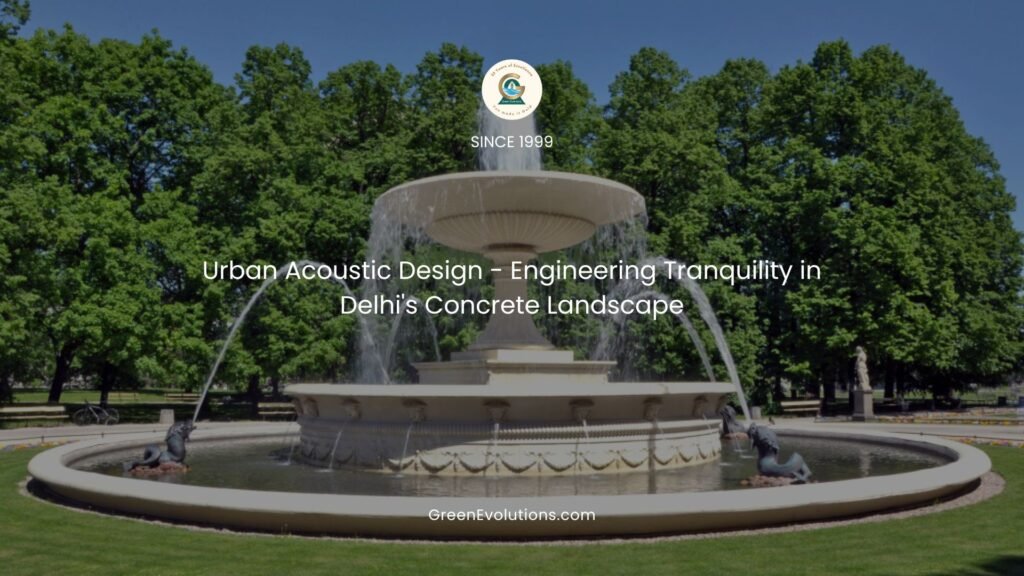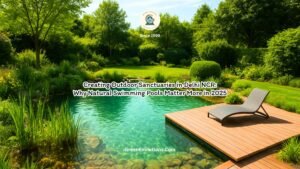Introduction: The Sound Crisis in India’s Capital
Delhi NCR ranks among the world’s noisiest metropolitan areas, with average noise levels consistently exceeding WHO recommendations by 15-20 decibels. This acoustic pollution affects every aspect of urban life, from residential comfort to commercial productivity, creating a hidden health crisis that influences property values, lifestyle quality, and business success.
Water features represent one of the most effective natural solutions for urban acoustic management, providing sound masking that doesn’t just reduce perceived noise levels but actively improves psychological well-being through biophilic audio environments. After three decades of designing urban water installations across the National Capital Region, we’ve documented measurable improvements in acoustic comfort, stress reduction, and property desirability through strategic water feature placement and design.
Client locations and specific acoustic measurements have been generalized throughout this analysis to protect privacy while accurately representing the principles and outcomes of urban acoustic design.
The Science of Sound Masking Through Water Design
Frequency Analysis and Acoustic Psychology
Urban noise pollution consists primarily of harsh, angular frequencies (traffic, construction, mechanical systems) that trigger stress responses and prevent relaxation. Water features produce consistent, broadband sounds in frequencies (1000-4000 Hz) that naturally mask unpleasant urban noise while triggering parasympathetic nervous system responses.
A residential complex in DLF Phase 2 documented complete elimination of traffic noise perception within 15 meters of their custom water feature, creating a “quiet zone” where residents could enjoy outdoor spaces that had been unusable due to road noise.
Specific location generalized to protect client confidentiality while preserving acoustic effectiveness data.
Multi-Source Design for Enhanced Coverage
Single water sources create directional sound masking that leaves acoustic “shadows” where urban noise remains problematic. The most effective installations use multiple water sources at varying heights and volumes to create enveloping acoustic environments that provide consistent sound masking throughout target areas.
Strategic Applications for Urban Environments
Residential Properties: Reclaiming Outdoor Living Spaces
Delhi’s affluent neighborhoods face constant challenges from traffic, construction, and urban activity that make outdoor relaxation difficult despite spacious properties and beautiful landscaping. Strategic water feature placement can restore usability to terraces, gardens, and courtyards that residents have abandoned due to noise pollution.
A client in Friends Colony reported fundamental changes in family lifestyle after installing a series of cascading pools: “We used to keep all windows closed during the day. Now we can open the ones facing our water feature. It feels like we got our garden back.”
Commercial Applications: Creating Competitive Advantages
Businesses that depend on client comfort and employee satisfaction gain significant advantages through acoustic water feature design. Restaurant outdoor seating, corporate meeting areas, and retail spaces all benefit from natural sound masking that enables normal conversation without shouting over urban noise.
A corporate campus in Cyber City documented increased usage of outdoor meeting areas after installing water features, with employees choosing outdoor lunch locations over indoor cafeterias for the first time since the building’s construction.
Healthcare and Educational Environments
Medical facilities and educational institutions require acoustic environments that support healing and concentration. Water features provide natural sound masking that reduces stress while avoiding the mechanical feel of artificial white noise systems.
Design Principles for Maximum Acoustic Impact
Height Variation and Sound Layering
Water falling from different heights creates distinct acoustic frequencies that combine to produce rich, natural soundscapes. Two-foot drops create gentle trickling sounds, while six-foot cascades produce broader frequency coverage that masks traffic noise more effectively.
Strategic Placement for Acoustic Shadows
Understanding how sound travels and reflects in urban environments allows strategic water feature placement that maximizes acoustic benefit. Features positioned to interrupt direct sound paths between noise sources and protected areas provide superior masking compared to arbitrary placement.
Seasonal Adaptation
Delhi’s seasonal variations affect both urban noise patterns and acoustic preferences. Water features must adapt to provide appropriate sound levels during quiet winter evenings and louder summer days when air conditioning and traffic intensify urban noise.
Material Selection and Acoustic Engineering
Surface Materials and Sound Production
Different materials create distinct acoustic signatures when contacted by falling water. Smooth granite produces clear, bright sounds while rough stone surfaces create softer, more diffused acoustic effects. Strategic material selection enables fine-tuning of acoustic environments for specific applications.
Circulation Design for Consistent Audio
Maintaining consistent water sounds requires sophisticated circulation systems that provide steady flow regardless of evaporation, wind effects, and seasonal variations. Variable-speed pumps and reservoir management ensure reliable acoustic performance.
Integration with Architecture and Landscape
Building Material Interactions
Water features must complement rather than compete with architectural acoustic properties. Hard surfaces like concrete and glass reflect sound differently than soft materials, requiring adjusted water feature design to achieve optimal acoustic results.
Landscape Buffer Integration
Combining water features with strategic landscape elements creates compound acoustic benefits. Dense plantings absorb high-frequency sounds while water features mask low-frequency urban noise, creating comprehensive acoustic management systems.
Conclusion: Strategic Investment in Urban Comfort
Urban acoustic design through water features represents strategic investment in quality of life, property values, and business success. As Delhi NCR continues developing, properties that understand acoustic comfort will create sustainable competitive advantages while providing genuine wellness benefits for residents, employees, and visitors.




